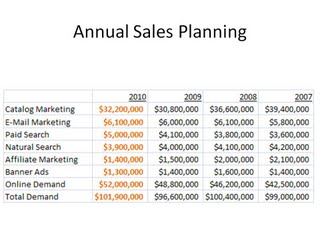Planning: The Smell Test
 When you are reviewing your sales plan for 2010, does it pass "the smell test"?
When you are reviewing your sales plan for 2010, does it pass "the smell test"?One of the first things you do when creating an annual sales plan is you build a sales forecast assuming that there are no changes in your advertising budget.
In other words, if all things are kept the same, what will the business look like in 2010?
When you look at this table, are there any numbers that stand out, that don't look right, that don't pass "the smell test"?
Look at the catalog marketing number. Sales via the telephone (catalog marketing) have declined by ten or twenty percent, per year, for the past three years. And yet, the business leader that approved the forecast is projecting an increase in 2010. Just looking at the numbers, assuming no advertising changes whatsoever, what would you project for a catalog marketing number in 2010?
Look at the Paid Search number in 2010. In a case like this, one needs to challenge the marketing executive, asking for the facts that cause this number to increase. What is being executed, from a Paid Search standpoint, that causes the marketing executive to think that sales will increase this much without a change in advertising spend?
Look at Online Demand for 2010. Again, this appears to be a reasonable increase, but what are the underlying metrics that cause this to happen? Increased traffic? Improved conversion rate? The marketing executive must demonstrate that, without a change in advertising budget, these metrics tie out in a way that causes an increase in volume.
When planning sales for 2010, you first create a "base case", one that shows what happens to the business without any changes to the advertising budget. This forecast must pass "the smell test". Once it passes "the smell test", you may move forward with changes to the marketing plan.
Labels: Planning
0 Comments:
Post a Comment
Links to this post:
Create a Link
<< Home